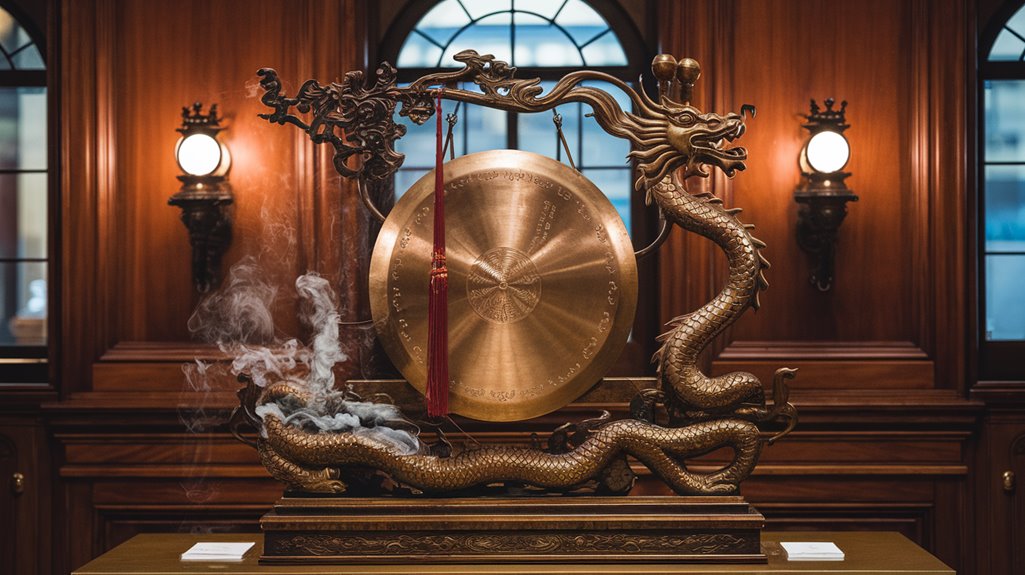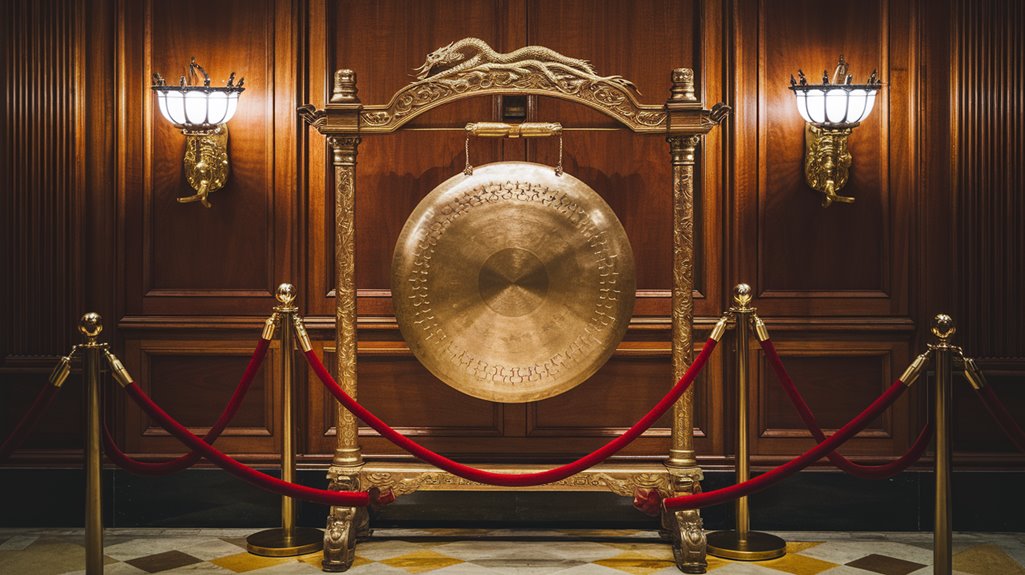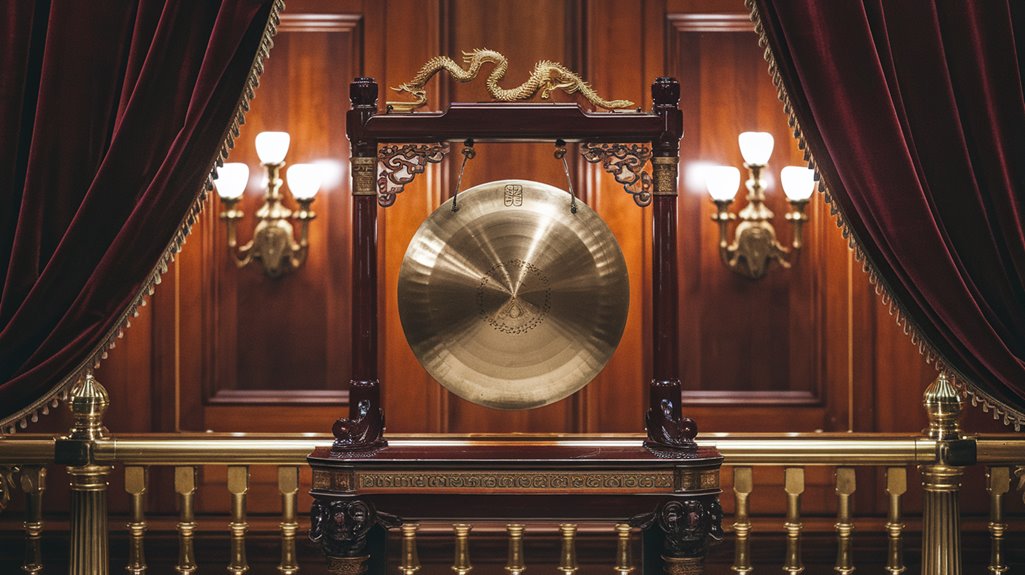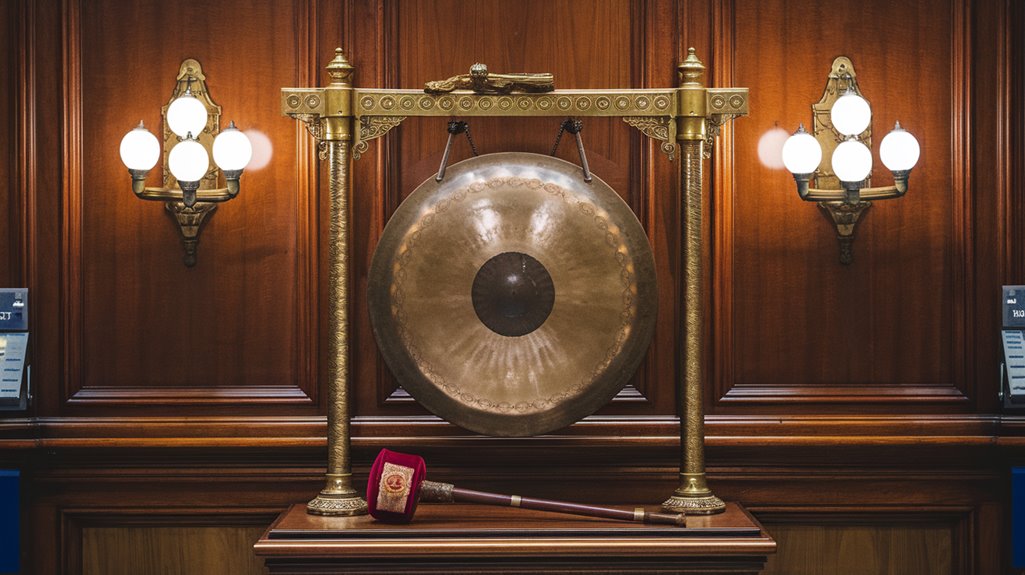The NYSE Used a Chinese Gong Before 1903
Like the rhythmic beats that once guided ancient traders along the Silk Road, you'll find it fascinating that Wall Street's most iconic institution once relied on a Chinese gong to conduct its daily business. You've probably seen countless images of the famous NYSE bell-ringing ceremony, but there's a lesser-known story of cultural fusion that preceded it. The shift from gong to bell in 1903 marked more than just a change in sound—it reflected America's evolving financial identity at the turn of the century.
Origins of the NYSE's Chinese Gong

In the bustling trading floors of the 1870s, the NYSE needed a powerful signal to mark the opening and closing of daily trading sessions.
You'll find that this need arose from the continuous trading environment, where clear communication was essential for all participants.
The NYSE's trading history took an interesting turn when they chose to replace their traditional gavel with a Chinese gong.
The gong sound proved to be the perfect solution, as its thunderous resonance could reach every corner of the trading floor.
Similar to the courtroom gavel, this early signaling method helped maintain order and structure in trading activities.
Much like modern public intellectual discourse, these signals fostered organized discussion and debate among traders.
This distinctive signal became a significant part of daily operations, with traders responding to its commanding tone to start and end their sessions.
The gong's effectiveness in managing trading activities continued until 1903, when the exchange moved to its new location and adopted an electrically operated brass bell.
The Daily Trading Rituals With the Gong
Each morning, traders gathered on the NYSE floor to witness the thunderous sound of the Chinese gong that marked the start of the trading day.
You'd find this trading tradition deeply rooted in symbolism, as the gong's resonant tones commanded attention and respect from all present.
The daily ritual wasn't just about marking time – it represented the heartbeat of capitalism itself.
Most traders preferred the gong's ceremonial nature, until it was replaced in 1903 with an electronic brass bell that would become the new standard.
As part of these ceremonies, you'd see traders applauding, especially when distinguished guests were invited to strike the gong. The ceremony typically begins with a formal reception at 8:30 AM.
This tradition carried significant cultural weight, much like today's bell-ringing ceremonies at various exchanges worldwide.
While the NYSE switched to a brass bell in 1903, the use of gongs continues at other exchanges, like Euronext Amsterdam, where they've maintained this practice since the 17th century.
Transition From Gong to Bell in 1903
When the NYSE relocated to 18 Broad Street in 1903, it marked the perfect opportunity to modernize its trading signals by replacing the Chinese gong with an electrically operated brass bell.
You'll find that this change wasn't just about changing instruments – it represented a significant upgrade in how the exchange managed its daily operations.
While the gong sound had served its purpose well since the 1870s, the new bell offered superior functionality with its melodious chime that could resonate throughout the expanded trading floor. The bell has become such a significant symbol that the NYSE now holds trademark rights to its distinctive sound.
The electrical operation also provided more reliability and control compared to the manually struck gong with its padded hammer.
Today, you can hear this same bell twice daily at 9:30 a.m. and 4:00 p.m. Eastern time, marking the opening and closing of trading sessions. In fact, on Thursday, Donald Trump will join the distinguished list of guests who have had the honor of ringing this historic bell.
Cultural Exchange and Market Traditions
The NYSE's decision to use a Chinese gong before 1903 reflects a broader pattern of cultural exchange in financial markets.
You'll find that cultural symbolism played an essential role in shaping market identity, as evidenced by the early NYSE's adoption of this Eastern instrument for trading signals.
This practice wasn't unique to New York – you can still witness similar traditions at Euronext Amsterdam, where they continue to use a gong.
When the NYSE moved into its new building designed by George B. Post, the traditional gong was replaced with a brass bell that still marks trading sessions today.
It's fascinating to see how these cultural elements have become deeply embedded in market operations worldwide. Cross-cultural communication requires understanding different cultural contexts to properly interpret and appreciate such shared traditions.
The integration of diverse cultural symbols in financial markets demonstrates how institutions historically embraced cross-cultural practices to establish their unique identities.
Today, you'll notice this legacy continues through ceremonial practices that blend tradition with modern market operations.
Legacy of the Original NYSE Gong

Standing as a symbol of market tradition until 1903, NYSE's Chinese gong marked pivotal moments in trading history before giving way to modern innovation.
 centrality measures help identify influential stocks in modern markets, the gong served as a central point of focus for traders during its era.
centrality measures help identify influential stocks in modern markets, the gong served as a central point of focus for traders during its era.
Ten-year-old Leonard Ross made history in 1956 as the first guest invited to ring the opening bell after winning a television game show about stock market knowledge.
While other exchanges like Euronext Amsterdam continue to use gongs, the NYSE's shift showcases its evolution toward technological advancement.
Today, four synchronized bells operate throughout the trading areas, but the memory of the original gong lives on through historical documentation and the NYSE building's recognition as a National Historic Landmark.
Modern Bell-Ringing Ceremonies and Their Significance
Modern bell-ringing ceremonies at the NYSE have evolved into highly publicized events that capture global attention twice daily.
You'll find these trading traditions are essential for maintaining market order, ensuring no trades occur outside designated hours. The bell significance extends beyond mere timekeeping – it's become a powerful marketing tool for the exchange and participating companies.
When you look at today's ceremonies, you'll see they've transformed into social media spectacles. Before adopting their current system, the NYSE used a Chinese gong to signal trading hours. The NYSE actively promotes these events across platforms like Twitter, Facebook, and LinkedIn. Companies can receive extensive media exposure through paid advertising campaigns designed to boost visibility during their ceremonies.
Companies leverage these moments for maximum publicity, especially during milestone events like IPOs and mergers. The ceremonies often feature celebrities and distinguished guests, making them coveted opportunities for listed companies to showcase their achievements and enhance their market presence.










